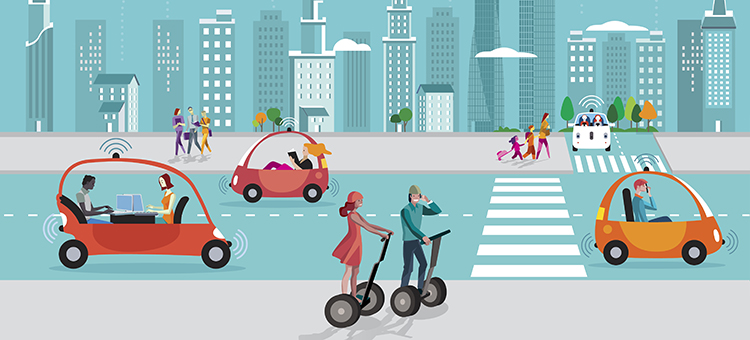Self-driving cars increase safety but require trust
In just ten years, self-driving cars could make traffic both safer and more environmentally friendly. But lack of legislation and trust can put this development at a halt, says Professor Erik Ström at Chalmers.
Heavy traffic of autonomous vehicles driving at a very close range. It might be hard to grasp that this future scenario – which is actually not very distant – equals enhanced traffic safety and lower emissions. But it does, says Erik Ström, SAFER's competence area leader for Sensors and Communications and professor at the Department of Electrical Engineering at Chalmers University of Technology, who is attending Chalmers’ seminar on future transport next week.
“When we share data, certain types of accidents are reduced; in the long run there should be no accidents at all. The efficient driving also reduces fuel consumption and exhaust emissions. In addition, we can make better use of the roads, driving closer together and in narrower lanes. This is a huge benefit as construction of new roads is expensive and has a major environmental impact.”
The technology of self-driving cars has come a long way. Erik Ström describes autonomous driving as a step-by-step process, where step one is manual driving and step five is completely self-driving cars. Many cars already have, for example, cruise control, warning signals if the car departs from the lane, or automatic braking if you come to close to the car in front of you. But the implementation of the technology depends on other factors, such as commercial interests and legislation.
“If an accident were to occur: Who is responsible? Are you responsible, sitting in your car even though you are not driving? Or is it the car manufacturer, or the provider of data sharing technology?” says Erik Ström.
“Trust is also an issue. Car manufacturers have to rely on each other in order to share data. And the public need to trust the technology.”
For example: In order for us to trust the autonomous cars, communication between cars and pedestrians is necessary. Today, a person crossing the street makes eye contact with the driver, and a nod or gesture indicates that it’s safe to pass. But what will happen in the future? Most likely, the cars need to be able to “wink” or “smile” to show that the pedestrian is registered.
Also, there is the question of privacy. How will the large amounts of data be handled, without compromising personal privacy? And how do you protect the system from being hacked?
“There is always a risk of hacking, but we can make it difficult enough to not be worth the trouble. We have to balance benefits and risks. It’s like the Internet; being online always entail the risk of hacking, but to most of us it’s worth the risk,” says Erik Ström, adding that it’s still unclear who should pick up the bill of data security.
The self-driving cars will probably run slower than cars today. But it doesn’t matter. We will still arrive faster, as cars can interact better on the roads. And:
“You don't have to spend time parking. You will be able to step out of the car at your destination, and the car will park itself,” says Erik Ström.
Note: Chalmers Area of Advance Transport organises the Initiative seminar Transportation in the Age of Digitalisation on September 26. Read more here: https://www.chalmers.se/en/areas-of-advance/Transport/calendar/initiative-seminar-2019/Pages/default.aspx
Text: Mia Malmstedt
Photo: Oscar Mattsson/iStock


